Tutorial 3: Importing individual anatomy
Contents
Dataset description
The dataset that will be used for all the introduction tutorials is a somatotopy experiment recorded with a CTF MEG system (151 axial gradiometers, La Salpetriere Hospital, Paris): shuffled electrical stimulations of the thumb fingers from both hands. Data files contain averages of 400 trials for each side. The idea is to get a map of the primary sensory response on the cortex. Data provided courtesy of Sabine Meunier.
Please download sample_ctf.zip from the Download section. Unzip it in a folder you will dedicate to original data. It can be anywhere but not in the Brainstorm database or program folder. Example:
Windows: My documents\MEG\sample_ctf\
Linux: /home/username/MEG/sample_ctf/
MacOS: Documents/MEG/sample_ctf/
Create protocol
Create a new protocol called TutorialCTF with the following options:
- "No, use individual anatomy", because the individual subject anatomy is available
- "No, use one channel file per condition (MEG)", because we have different runs with different head positions to import for the same subject
Create a new subject (let's keep the default name: Subject01)
Import MRI
Go to the Anatomy view of the protocol files (very first button in Brainstorm window toolbar).
Right click on subject node, and select menu "Import MRI..."
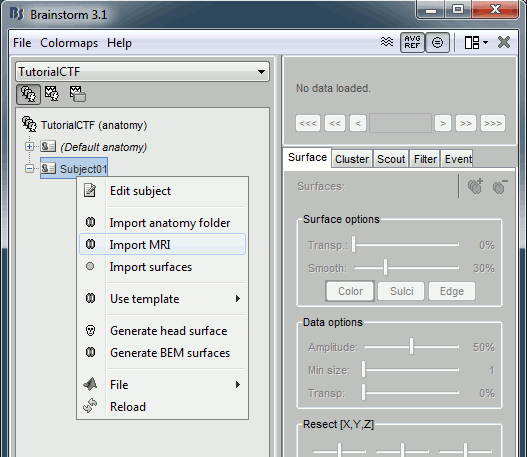
Select file "sample_ctf/Anatomy/01.nii"
Make sure to select one of the correct file format: either "All MRI files" or "MRI: NIfTI-1 (*.nii)"- The MRI viewer is displayed, together with a message box that tells you what to do. Follow the instructions. The MRI is already well oriented so you can directly process with the fiducials selection: Nasion, left ear, right ear, anterior commissure, posterior commissure, and inter-hemispheric point.
For instructions to find those points, read the following page: CoordinateSystems.
Warning: This acquisition was done a long time ago, and the person who digitized the position of the nasion and ears before the MEG acquisition did not follow the indications from the previous page. The person pointed at the three markers that we can easily see on the MRI, that appear next to the real anatomical points as little white dots. In this case, you have to mark the points on the MRI slices in the same way that it was done at the MEG acquisition.
- The coordinates of the markers should be around the following coordinates (MRI, in mm)
- NAS = [115.3 207.2 138.8]
- LPA = [ 45.9 128.4 71.3]
- RPA = [186.6 123.8 83.4]
- AC = [115.3 130.3 132.2]
- PC = [115.3 102.2 133.1]
- IH = [113.4 109.7 184.7]
You can enter directly type the position of the fiducials with the followinfg popup menu:
right-click anywhere in the MRI Viewer figure > Edit fiducials positions...Click on Save when you're done selecting the fiducials.
To check were the fiducials are or change their position later:
right-click on the MRI file > Edit MRI...
Import surfaces
The MRI is available in the anatomy folder for Subject01. Let's now proceed with the surfaces. The envelopes we are going to import in this tutorial were extracted using BrainVISA, and their names and types may differ from other software solutions. To learn how to get those surfaces by yourself: read the tutorials for BrainVISA, FreeSurfer or BrainSuite.
Right click on the subject node again, and click on "Import surfaces...". Select at the same time (holding the Shift, Ctrl or Cmd key) all the files in the directory "sample_ctf/Anatomy/BrainVISA" (head, Lhemi, Rhemi). Click on "Open".
Make sure to select the correct file format: "All surface files (*.*)" or "BrainVISA (*.mesh)"You should see the three surfaces in the database tree.
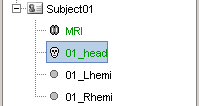
One has been identified automatically as a scalp (=head) surface, because its original filename contained the "scalp" keyword. Usually, Brainstorm identifies file types with this kind of tags in the file names.
The two other files were not identified automatically. They contain the envelopes of the left and right hemispheres of the brain, but Lhemi and Rhemi are not keywords that are identified automatically by Brainstorm.
Try to display the surfaces by double-clicking on them, or with the popup menu Display.
Downsample and merge surfaces
At the bottom of the Surface tab, you can see the numbers of faces and vertices for each surface, and also display their faces (wireframe) with the Edge button. They look great, but their resolution is too high for the algorithms we will apply on them later, so they need to be resampled.
- Downsampling:
Right-click on 01_head > Less vertices... > 7000 vertices. Ok.
Select the default resampling method: "Matlab's reducepatch". Ok.Select simultaneously Lhemi and Rhemi > Right-click > Less vertices... > 7500 vertices. Ok.
Select the default resampling method: "Matlab's reducepatch". Ok.- Three new surfaces appeared in the list, with the number of vertices as a suffix.
Group the left and right hemispheres to build a Cortex surface:
Select simultaneously Lhemi_7500V and Rhemi_7500V > Right-click > Merge surfaces
A file called cortex_15000V appears in the list. Its icon is different from the Lhemi and Rhemi surfaces: the surface was classified automatically as a cortex envelope.
To set manually the type of a surface : right-click > Set surface type > Cortex
Like all the files in the database, the surface can be renamed: F2 key, or click twice on it (wait between the two clicks), or right-click > Rename.
Double-click on it to display it (or right-click > Display), and check in the Surfaces tab that the number of vertices is about 15000.
- Multiple surfaces of the same type:
You are in a configuration where two surfaces are classified as head.
- The one displayed in green is considered as the default one. It will be used automatically by all the functions that need the head surface for this subject.
Double-click on the other head surface to select it (or right-click > Set as default scalp). It should turn green.
However, having multiple surfaces of the same type is not the recommanded way to proceed, as it might be confusing. To make things clear, always set as "Other" the surfaces you are not going to use in the source estimation process (their icon should be a gray dot).
- A bit of cleaning:
Rename the 01_head_7000V to head. Set it as the default scalp (green).
Delete all the surfaces but the MRI, head and cortex (Delete key, or right-click>Delete).
Before:
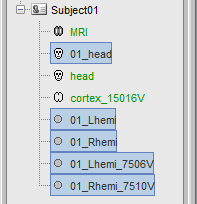 After:
After: 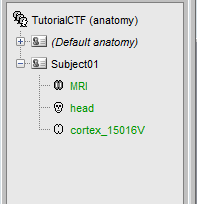
Bug warning
Description: On some operating systems, it may happen that the tree is not refreshed well. Just after adding new files, the database tree can be displayed incompletely or can even appear completely empty. This bug occurs sometimes because the interactions between Matlab and Java are not always well synchronized.
Workaround: If this happens, just refresh the tree display with either pressing the F5 key or changing the display mode.
Automatic import
The import of the MRI and the surfaces was done manually in the previous sections to introduce the tools. However, you will most likely not have to follow all those steps on your own data, as it is now possible to import the entire segmentation folders with just one click, with the menus: Import FreeSurfer folder, Import BainVISA folder, Import BrainSuite folder. Additionally, new menus are available to generate head surfaces from the MRI.
Check registration with MRI
Your Subject01 anatomy is ready for source estimation. But before going further, you should always check that surfaces and MRI are well registered. When performing those steps a bit too fast, it is really easy to end up with a cortex envelope that is not aligned with the MRI. None of the following steps in source estimation will check that for you, and the sources estimated would be completely wrong.
Right-click on the Cortex surface > MRI Registration > Check MRI/surface registration...
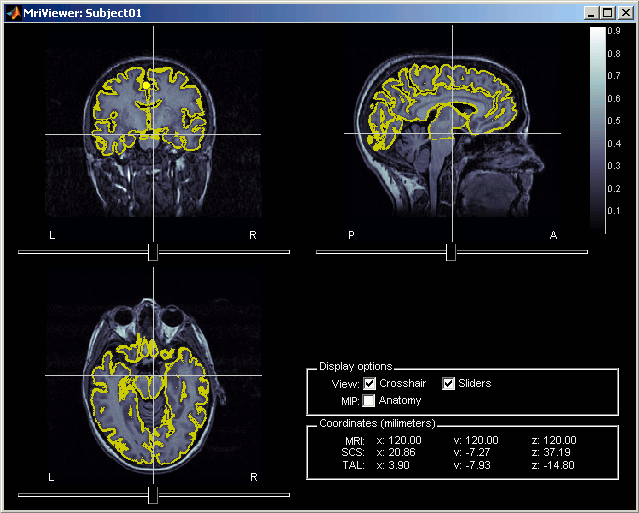
- The calculation of the interpolation MRI-surface takes a few seconds, but it is then saved in the database and will be reused later.
- The yellow lines represent the re-interpolation of the surface in the MRI volume. The computation may take a while, but the result will be stored in the surface file, and will be useful for other operations anyway.
Fix registration with MRI
In some rare cases, the surfaces may not be registered correctly with the MRI.
- If this happens, delete your MRI and surfaces and start again from scratch, it may be a manipulation mistake.
- If the result is not better and you don't know what happens, it is likely that the coordinate system used in your surface file is not handled by Brainstorm. There are still two emergency possibilities: pointing the fiducials on the head surface, and editing manually the surfaces. Both options give really unprecise results, but might help if nothing else is possible...
- You would not need to use this with the present tutorial data, as the surfaces are already well registered with the MRI. But go through the following steps anyway, so that you know what to do in case it happens.
Defining the fiducials on head surface
- Of course this is possible only if you have the head surface.
Right-click on the head dsurface > MRI Registration > Edit fiducials...
You will be asked to point on the scalp surface the same fiducials as in the MRI (NAS, LPA, RPA). Click on a button in the toolbar on the top (NAS, LPA or LPA) to activate it (grey shading), and point the right spot on the surface. Repeat this operation for each fiducial.
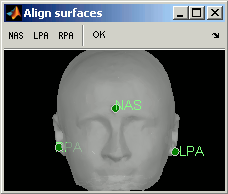
Do not save the changes when closing the "Align surfaces" window. Normally you would save the changes to realign all the subject's surfaces. However, here we don't want to alter our perfect subject, so just answer No to the question "Would you like to save the changes ?" and the modifications will be ignored.
Manual alignment
- The goal is to realign graphically and interactively one surface based on another.
Right-click on Cortex > MRI Registration > Align manually on... > Head
The orange surface is the one you are modifying, the grey one is the target. Move your mouse over the buttons in the toolbar to see what they do, select one you like, and then use right-click + move up/down
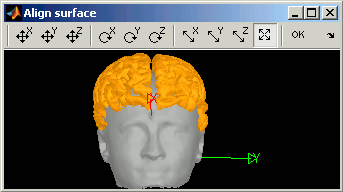
Do not click on OK (normally you would click on the OK button of the toolbar, and it would realign all the subject's surfaces). Close the window, and answer No to the question "Would you like to save the changes ?"
Check one last time that we didn't modify anything: Right-click on Cortex > MRI registration > Check.
What happened on the hard drive
For most manipulations, it is not necessary to know exactly what is going on at the level of the file system, in the Brainstorm database directory. However, many things are not accessible from the Brainstorm interface, you may find sometimes useful to manipulate some piece of data directly from the Matlab command window.
The right-click > File menu, accessible on all the nodes in Brainstorm database explorer, offers many tools to interact with the file system and the Matlab environment.
Where are the files ?
Several ways to reach a file:
Leave your mouse during a few seconds over any node in the database explorer, and a tooltip will appear, with the name and path of the corresponding file on the hard drive.
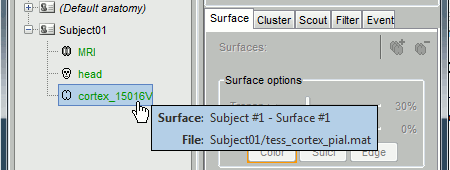
Paths are relative to current protocol path (brainstorm_db/TutorialCTF). What is displayed in the Brainstorm window is a comment and may have nothing to do with the real file name. Eg. the Cortex surface's real file name is tess_cortex_pial.mat.
- Almost all the files in the database (imported data or computation results) are in Matlab .mat format. As a consequence, you can load them really easily in the Matlab environment, where they appear as structures with several fields.
Popup menu: File
Right-click on a surface file: many menus can lead you to the files and their contents:
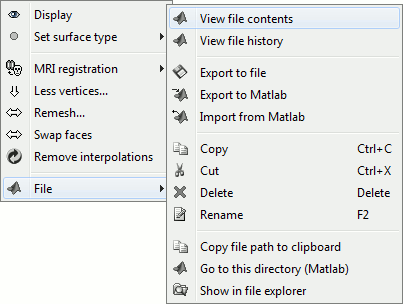
View file contents: Display all the fields in the corresponding Matlab .mat file and the file path
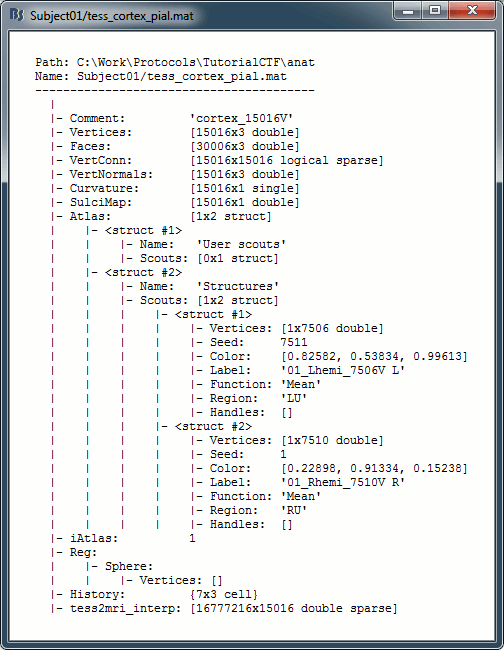
View file history: Review the History field in the file, that records all the operations that were performed on the file since if was imported in Brainstorm

Export to file: Export in one of the supported mesh file format
Export to Matlab: Load the contents of the .mat file in the Matlab base workspace. It is then accessible from the Matlab command window.
Import from Matlab: Replace the selected file with the content of a variable from the Matlab base workspace. Useful to save back in the database some structures that where exported and modified manually with the Matlab command window.
Copy / Cut / Paste: Allow you to copy/move files in the database explorer. Keyboard shortcuts for those menus are the standard Windows shortcuts (Ctrl+C, Ctrl+X, Ctrl+V). The tree also support drag'n'drop operations for moving files between different folders.
Delete: Delete a file. Keyboard shortcuts: Delete key.
Rename: Change the Comment field in the file ("renames" the file in the database explorer, but does not rename the actual file on the hard drive). Keyboard shortcut: F2
Copy file path to clipboard: Copies the full file name into the system clipboard, so that you can paste it in any other window (Ctrl+V or Paste menu)
Go to this directory (Matlab): Change the current Matlab path, so that you can access the file from the Matlab Command window or the Matlab Current directory window
Show in file explorer: Open an explorer window in this directory (not working on all the systems...)
Open terminal in this folder: Start a system console in the file directory (Linux, Unix, MacOS only)
What are all those other files ?
If you look in your brainstorm_db/TutorialCTF directory with the file explorer of your operating system, you'll find many other directories and files that are not visible in Brainstorm database explorer.
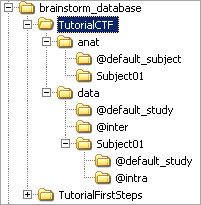
The protocol TutorialCTF is divided in Anatomy and Datasets directories:
Each subject in anat is described by an extra file: brainstormsubject.mat
Each condition in data is described by an extra file: brainstormstudy.mat
anat/@default_subject: contains the files that are displayed in the (Default anatomy) node in database explorer
data/@default_study: used when files are shared between different subjects, node (Global common files)
data/@inter: results of inter-subject analysis
data/Subject01/@default_study: used when files are shared between different conditions in Subject01; node (Common files)
data/Subject01/@intra: results of intra-subject analysis (across different conditions)
Feedback
Next
The anatomy of our subject is ready for source estimation, the next tutorial explains ?how to import recordings.